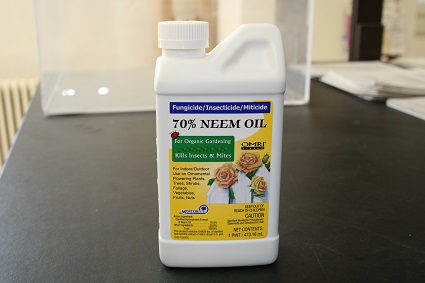

The term “neem” is often used in reference to both azadirachtin and neem oil. However, this is not entirely the correct use of this term. Neem, which is derived from the neem tree, Azadirachta indica is not a single substance. The seed kernels contain the highest concentrations of active compounds. Seeds are soaked in water and alcohol to extract any pesticidal constituents. After removal of the natural neem oil from the seeds, the subsequent neem oil is treated with alcohol, causing the azadirachtin and related substances to separate from the neem oil. The remaining oil without the azadirachtin is called clarified hydrophobic extract of neem oil. Therefore, the two main active ingredients derived from the neem tree seeds are azadirachtin and clarified hydrophobic extract of neem oil (also referred to as “neem oil”).
Azadirachtin
Azadirachtin is not a single compound but has a very complex structure being a mixture of related substances extracted from the neem seed kernels. Seeds are the only source of azadirachtin. Azadirachtin affects insects in many different ways including acting as an insect growth regulator, anti-feedent, repellent, sterilant, and oviposition inhibitor. As an insect growth regulator, azadirachtin is an antagonist (substance that acts against and blocks an action) that inhibits the synthesis or metabolism of the insect molting hormone, ecdysone. Consequently, by inhibiting the molting process and thus metamorphosis, this causes insects to die when transitioning into the next life stage or instar (insect stage between molts). Disruption of the insect life cycle prevents the production of future generations. Azadirachtin is more effective on the immature/young life stages of insects than eggs or adults. However, azadirachtin is slower-acting than conventional insecticides, which is primarily due to azadirachtin altering or modifying the behavior of insects. Azadirachtin works as a stomach poison in which insects must ingest the active ingredient during feeding to be negatively affected. Activity is better on chewing than sucking insects. This may be why azadirachtin is most effective against caterpillars. Azadirachtin has minimal contact activity against many insect pests and is most effective at warmer temperatures (>70°F or 21°C) with reduced efficacy at lower temperatures. Azadirachtin has been shown to have systemic properties with activity against certain insect pests although this depends on plant type and pH of the growing medium, with less systemic activity at pH’s >7.0 (alkaline). This is interesting because azadirachtin has a low water solubility (0.05 ppm). Some studies have reported that foliar applications of azadirachtin are effective in suppressing populations of the twospotted spider mite, Tetranychus urticae. Most commercially available products are labelled for use against many different insect pests including aphids, caterpillars, leafminers, mealybugs, scales, thrips, and whiteflies.
Clarified Hydrophobic Extract of Neem Oil
Clarified hydrophobic extract of neem oil (neem oil) works by suffocating (blocking breathing pores) insect and mite pests. Neem oil is primarily active on soft-bodied insect and mite pests such as aphids, whiteflies, spider mites, mealybugs, and scales. Neem oil may kill eggs, immatures (larvae or nymphs), and adults. However, neem oil only has contact activity so it is important to obtain thorough coverage of all plant parts and make repeat applications based on label recommendations. Commercially available products are typically labelled for use against a wide-range of pests such as aphids, leafhoppers, mealybugs, mites, scales, and whiteflies.
Azadirachtin and clarified hydrophobic extract of neem oil have short residual activity, mainly due to their susceptibility to ultra-violet light (sunlight) degradation. Therefore, repeat applications are usually required. Both compounds have low toxicity to humans and mammals with an LD50 >5,000 mg/kg. In addition, azadirachtin and clarified hydrophobic extract of neem oil, in general, are less harmful to most natural enemies (parasitoids and predators) than conventional pesticides.
Raymond A. Cloyd is a Professor and Extension Specialist in Horticultural Entomology/Plant Protection and Kansas State University. He can be contacted at:
Kansas State University
Department of Entomology
123 Waters Hall
Manhattan, KS 66506-4004
Email: rcloyd@ksu.edu
Related Articles & Free Email Newsletter
An Easy and Inexpensive Way to Eliminate Fungus Gnats
How To Identify & Manage Sowbugs and Pillbugs




Comment here